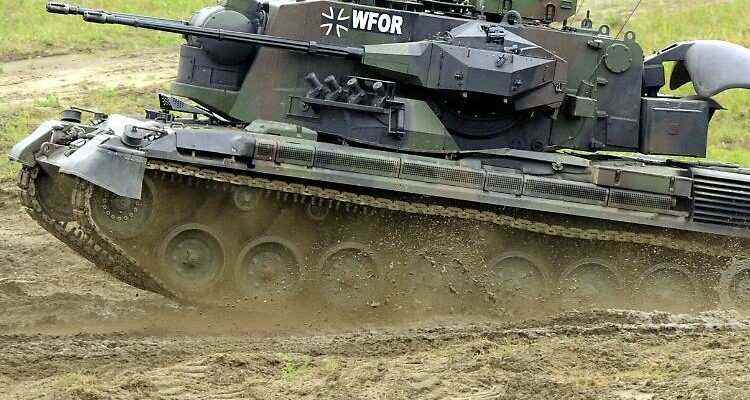Upgraded anti-aircraft tanks
That’s what the German “Gepard” can do
By Martin Morcinek
07/25/2022, 3:13 p.m
Germany is supplying heavy military equipment to the Ukraine: Months after the federal government’s export license, the Ukraine is receiving the first “Gepard” anti-aircraft tanks. What can the decommissioned Bundeswehr tanks do?
Heavy weapons made in Germany are used in the Ukraine war: Ukraine received the first Gepard anti-aircraft tanks from Germany. The delivery is based on an agreement with Defense Minister Christine Lambrecht in May. At that time, after weeks of hesitation, the federal government had decided to release tank deliveries for the war-torn country. The first three German cheetahs have now reached the Ukraine together with several thousand rounds of special ammunition. Twelve more cheetahs are expected.
The earlier Bundeswehr tanks have been in stock at the manufacturer Krauss-Maffei Wegmann (KMW) since they were officially phased out ten years ago. According to KMW, they were technically reworked there and brought up to date. Because they are weapons of war, the used tracked vehicles could not simply be resold. According to German law, a license from the federal government was required for the export of armaments.
In the fight against the Russian invading army in Ukraine, the anti-aircraft tanks from German stocks could definitely prove to be helpful: the approximately 48-ton weapon systems are designed to defend against low-flying attackers such as attack helicopters or fighter jets. In their role as escort tanks in the Bundeswehr, they were primarily intended for mobile anti-aircraft defense to protect tank columns.
The cheetahs are equipped with a radar-controlled twin automatic cannon with a caliber of 35 millimeters. The radar sensors on the battle turret, which can be swiveled all around, can detect targets up to a distance of 15 kilometers, day and night and in all weather conditions, as the manufacturer emphasizes. In an emergency, a laser range finder provides the three-man crew with the target data, which is automatically transmitted to the tower control in the “digital fire control computer”. The on-board computer aligns the guns, pivots with the approaching target and – depending on the speed of the attacker – also provides the necessary lead angle for the guns.
Weighing around 48 tons and almost eight meters long: The Bundeswehr returned its last Gepard anti-aircraft tanks to the manufacturer by 2012.
(Photo: dpa)
If the tank commander gives the go-ahead, the two Gepard guns fire at the target at a theoretical rate of 1100 rounds per minute. However, the ammunition supply on board is only sufficient for short bursts of fire. The maximum range of the rapid-fire cannons is around 6000 meters. The effective combat distance is significantly lower: the German cheetahs can do little against bombers, rockets or cruise missiles flying higher than 2500 meters.
The all-terrain cheetahs reach a top speed of up to 65 kilometers per hour with their 830 hp drive. When transported by road, the more than 900 liters of fuel on board are sufficient for a distance of around 550 kilometers. However, the ten-cylinder multi-fuel engine can be refueled with all common types of fuel on the go. However, the cheetah is better able to cover longer distances by rail: the dimensions of the vehicle allow it to be loaded onto standard freight cars.
“The high degree of mobility off-road and the rapid pivoting of the turret enable the necessary extremely short response times to threats from the air,” the manufacturer advertises the capabilities of the model. “Whether combat helicopter, combat aircraft or drone, the targets are safely fought with the two 35mm automatic cannons.” However, the approximately three and a half meter long guns can also be aimed at ground targets if necessary. There they can have a devastating effect in an emergency: Special armor-piercing ammunition makes the Cheetah a dangerous opponent for attacking infantry fighting vehicles.
However, the military planners saw no future for the “Gepard” model in the Bundeswehr. The weapons technology, which essentially dates back to the 1960s, was considered superfluous and outdated after the turn of the millennium. Flexible anti-aircraft teams with man-portable “Stinger” anti-aircraft missiles should take over from the cumbersome, expensive and noisy Cheetahs. In the Ukraine, the German Gepard tanks are said to protect cities, bridges and other facilities of the so-called critical infrastructure against attacks from the air.
In the German army, the last Gepard anti-aircraft tanks had had their day in 2010: after the peaceful end of the Cold War and with the realignment of the German army, the special vehicles in Germany had become superfluous. The outdated Gepard system fell victim to the need to economize. Export partners such as Brazil or Qatar occasionally took over decommissioned Gepard tanks. A total of more than 570 anti-aircraft tanks of this type were built under the direction of KMW. According to the manufacturer, the latest versions can also “reliably” combat remote-controlled missiles, rockets and even drones.
The Gepard tanks were designed for Cold War-era conflict scenarios. With their firepower, as defense and escort vehicles, they should be able to follow NATO main battle tanks through difficult terrain in an emergency. When building the Gepard tank, KMW therefore adopted the body and chassis of the Leopard 1 main battle tank. The twin automatic cannons on either side of the turret, on the other hand, came from the Swiss armaments manufacturer Oerlikon.
This is exactly what caused the planned Gepard deliveries to Ukraine to falter at times: the Swiss arms export control initially rejected the supply of ammunition. The projectiles were previously produced by Rheinmetall in Switzerland. The required clearance from Bern blocked the supply of ammunition, and without the special 35mm shells, the German tanks were completely useless to the defenders in Ukraine. It was only at the beginning of July that the federal government in Norway was able to find a suitable manufacturer who was ready to deliver. The training of Ukrainian gunners could begin.
This article was first published in modified form on April 26, 2022.
